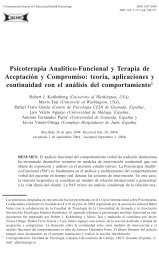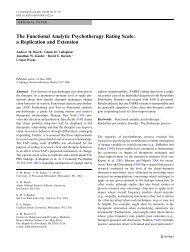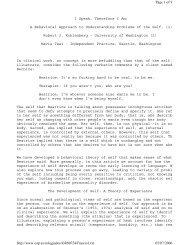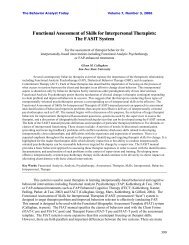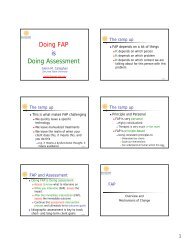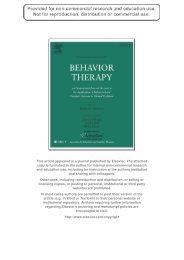Rule #1 - Functional Analytic Psychotherapy | FAP
Rule #1 - Functional Analytic Psychotherapy | FAP
Rule #1 - Functional Analytic Psychotherapy | FAP
Create successful ePaper yourself
Turn your PDF publications into a flip-book with our unique Google optimized e-Paper software.
<strong>Functional</strong> <strong>Analytic</strong><br />
<strong>Psychotherapy</strong>:<br />
The Basics (Part 1)<br />
Robert J. Kohlenberg, Mavis Tsai, Reo W.<br />
Newring, Christeine M. Terry, Mary D. Plummer,<br />
Madelon Y. Bolling, Chauncey Parker<br />
© University of Washington, 2005
<strong>FAP</strong> is…<br />
• A treatment built from a handful of<br />
basic behavior analytic principles<br />
• Almost pure process; very few<br />
tricks or specific techniques<br />
• How to implement your techniques<br />
more powerfully<br />
• An extension of what many good<br />
therapists do naturally<br />
© University of Washington, 2005
Behavior Analysis:<br />
Stimulus Functions<br />
Therapists influence behavior via<br />
three stimulus functions:<br />
1. Elicit client behavior<br />
2. Evoke client behavior<br />
3. Consequate client behavior<br />
These functions will have their<br />
strongest effects on in-session<br />
client behavior.<br />
© University of Washington, 2005
Behavior Analysis:<br />
The time-space relationship<br />
Reinforcement is MORE EFFECTIVE if<br />
the reinforcer is delivered closer in<br />
time and space to the behavior<br />
Example: Reinforcing a client<br />
for disclosure immediately<br />
after it occurs vs. reinforcing<br />
a client for disclosure 2<br />
sessions later<br />
© University of Washington, 2005
Behavior Analysis: (cont.)<br />
Client Problems Can Be Observed and<br />
Reinforced Directly by the Therapist<br />
• Reinforcement occurs whether<br />
or not we are aware of it.<br />
• Therapists and clients inevitably<br />
and naturally shape each other’s<br />
behavior.<br />
• This usually occurs outside of<br />
awareness<br />
© University of Washington, 2005
Therapists & Clients<br />
Naturally Shape Each Other<br />
I’m still pretty<br />
upset. Can we<br />
spend a few<br />
more minutes<br />
CLIENT<br />
Ya,<br />
I’m<br />
I don’t<br />
sorry.<br />
mind<br />
going<br />
vee are<br />
a little<br />
out<br />
over<br />
off<br />
zee<br />
time<br />
time<br />
vor<br />
if<br />
vee<br />
today.<br />
need to.<br />
© University of Washington, 2005
Behavior Analysis: (cont.)<br />
Shaping client behaviors<br />
• Match expectations to your client’s<br />
current behavioral repertoire<br />
– If your client is seeking help for her<br />
inability to trust others in<br />
relationships, do not expect her to<br />
offer disclosures readily<br />
• Modeling<br />
• <strong>Functional</strong> Analysis<br />
© University of Washington, 2005
Match expectations with client's<br />
current repertoire<br />
That’s it, Dr. Linehan, I’m quitting<br />
therapy because you can’t spend<br />
enough time with me.<br />
THERAPIST<br />
CLIENT<br />
Well That’s I’m the certainly first time not<br />
going you ever to spend told me more the<br />
feelings time with that you make if you you<br />
think keep about treating quitting, me like so<br />
let’s talk this! about our<br />
time arrangements.<br />
NOT MATCHING<br />
© University of Washington, 2005
<strong>Functional</strong> Analysis<br />
Function vs. Form (topography) of<br />
behaviors<br />
• How does the client’s behavior<br />
serve him/her<br />
© University of Washington, 2005
Thinking Operantly<br />
(Video clip removed)<br />
• What operants might be occurring<br />
• How might the operants be relevant<br />
to client’s daily life problems<br />
• From an operant standpoint, what<br />
therapist activities are therapeutic<br />
Countertherapeutic<br />
© University of Washington, 2005
Basic Principles<br />
CRB: Clinically Relevant Behavior<br />
Let’s define target behaviors (i.e. operants).<br />
• <strong>Functional</strong> classes<br />
• Idiographic<br />
• Based on treatment goals and identified<br />
problems<br />
What behaviors, relevant to the client’s<br />
treatment goals & identified problems, will<br />
be elicited, evoked and reinforced during the<br />
session<br />
© University of Washington, 2005
Basic Principles<br />
CRB: Clinically Relevant Behavior<br />
CRB’s occur in session and can be<br />
addressed on the spot<br />
• CRB-1: Client problems occurring in session<br />
• CRB-2: Client improvements that occur in session<br />
Identify these to maximize therapeutic change<br />
(Video clips removed)<br />
© University of Washington, 2005
<strong>FAP</strong>: Mechanism of Change<br />
The therapist’s natural,<br />
contingent responding to<br />
decrease CRB-1s and increase<br />
CRB-2s<br />
This applies to workshops &<br />
supervision as well<br />
© University of Washington, 2005
Five <strong>Rule</strong>s of <strong>FAP</strong><br />
<strong>FAP</strong> comprises a set of simple rules for<br />
observing, evoking, responding to, and<br />
talking about CRBs.<br />
Concrete ways to bring more connection<br />
and intensity into your work!!<br />
© University of Washington, 2005
Five <strong>Rule</strong>s of <strong>FAP</strong><br />
<strong>#1</strong><br />
© University of Washington, 2005
<strong>Rule</strong> <strong>#1</strong>: Watch for CRBs<br />
If nothing else, do <strong>Rule</strong> 1<br />
(unobtrusively).<br />
The rest will follow naturally, if<br />
a) The behaviors are naturally in<br />
your repertoire.<br />
b) You have your clients’ best<br />
interests at heart.<br />
© University of Washington, 2005
<strong>Rule</strong> <strong>#1</strong>: Watch for CRBs (cont.)<br />
• Use case conceptualization as a<br />
guide<br />
• Assess for CRB-1s and CRB-2s:<br />
• Use Typical, Beginning, Middle and<br />
End of Therapy Questions to Assess<br />
CRBs<br />
• Therapeutic Opportunity Scale<br />
(TOS)<br />
© University of Washington, 2005
<strong>Rule</strong> <strong>#1</strong>: Watch for CRBs<br />
CLIENT<br />
How come so many<br />
people don’t like me!<br />
And how will talking to<br />
a %@^#*! JERK like<br />
you help<br />
THERAPIST<br />
CRB-1 <br />
(Cranky Albert)<br />
© University of Washington, 2005
<strong>Rule</strong> <strong>#1</strong>: Watch for CRBs<br />
Will you call<br />
my doctor<br />
and ask him<br />
to renew my<br />
Xanax<br />
prescription<br />
Therapist<br />
CRB-1<br />
OR<br />
CRB-2 <br />
Client<br />
© University of Washington, 2005
Five <strong>Rule</strong>s of <strong>FAP</strong><br />
#2<br />
© University of Washington, 2005
<strong>Rule</strong> #2: Evoke CRB’s<br />
• Treatment content will naturally<br />
evoke CRB’s<br />
– Free association, Agenda<br />
setting, Hypnosis, Homework<br />
assignments<br />
•Prompt CRB-2s<br />
• Do not change your behavior to<br />
evoke CRB’s<br />
(Video clip removed)<br />
© University of Washington, 2005
Five <strong>Rule</strong>s of <strong>FAP</strong><br />
#3<br />
© University of Washington, 2005
The clinical application of natural<br />
vs. arbitrary reinforcement:<br />
Arbitrary reinforcer Serves to please<br />
therapist. In future, client values therapists<br />
approval.<br />
Natural reinforcer Related<br />
consequences that are available in client’s<br />
daily-life environment. More likely to<br />
generalize.<br />
© University of Washington, 2005
Arbitrary reinforcement<br />
CLIENT<br />
Why must you always dissect my<br />
homework and evaluate my thinking<br />
It seems like some of my thoughts are<br />
valid and it’s kind of a put down to<br />
analyze them.<br />
Ben Stein<br />
(the epitome of<br />
non-emotive)<br />
It is so terrific that<br />
you are telling me<br />
how you feel!<br />
Good Job!<br />
What<br />
This<br />
might<br />
might<br />
be<br />
be<br />
a<br />
countertherapeutic…<br />
more NATURALLY<br />
REINFORCING response to the client’s<br />
emotional expression<br />
© University of Washington, 2005<br />
THERAPIST
Five <strong>Rule</strong>s of <strong>FAP</strong><br />
#4<br />
© University of Washington, 2005
<strong>Rule</strong> 4:<br />
Notice your effect on the client<br />
(Video clips removed)<br />
If a client is “stuck” and doesn’t seem<br />
to improve...<br />
© University of Washington, 2005
Five <strong>Rule</strong>s of <strong>FAP</strong><br />
#5<br />
© University of Washington, 2005
<strong>Rule</strong> #5: Provide functional<br />
interpretations of client behavior<br />
How does behavior serve the client<br />
Help the client understand how their behavior<br />
functions<br />
It seems like after a difficult<br />
homework assignment, you come in<br />
here with a bunch of other crises to<br />
talk about. This makes it so that we<br />
never get to discuss those difficult<br />
assignments. Was the homework too<br />
hard Did it bring up some stuff for<br />
you Is this what you do when things<br />
get tough<br />
© University of Washington, 2005<br />
THERAPIST
<strong>FAP</strong> Case Conceptualization<br />
Relevant History<br />
Daily Life<br />
Problems<br />
<strong>Psychotherapy</strong><br />
Daily Life<br />
Goals<br />
IN SESSION<br />
CRB-1s<br />
CRB-2s<br />
Watch<br />
RULE<br />
for<br />
and evoke<br />
CRBs<br />
Identify reinforcers<br />
and reinforce<br />
CRB-2s<br />
Provide rules &<br />
generalization<br />
strategies<br />
1 & 2 RULE 3 & 4 RULE 5
<strong>FAP</strong> Case<br />
Conceptualization<br />
Relevant<br />
History<br />
DL Problems<br />
IV Problems<br />
(CRB1s)<br />
IV<br />
Improvement<br />
s (CRB2s)<br />
Conceptualization is an<br />
ongoing process of assessing<br />
and revising hypotheses<br />
DL Goals<br />
© University of Washington, 2005
Some <strong>FAP</strong> Materials<br />
• Therapy Questions Handouts:<br />
Typical, Beginning, Middle, End<br />
– What do you think I’m thinking about<br />
you/that/what you did/said<br />
– I note these similarities and differences<br />
between my usual style of beginning and how I<br />
am beginning this relationship…<br />
– What regrets do you have about the therapy or<br />
what would you like to have gone differently<br />
© University of Washington, 2005
Some <strong>FAP</strong> Materials (cont.)<br />
• End of Therapy Letter to Client<br />
…“In working with you, I have grown<br />
tremendously as a therapist and a person. I am<br />
proud to have been a part of your life in the last<br />
two months, to have been a part of the great<br />
changes that you have gone through. I admire<br />
your courage, your determination, and your<br />
strength; and I have learned to be silent, and<br />
encouraging, and centered in order to keep up<br />
with you. I am learning what it means to sit<br />
with someone who sits with pain, an invaluable<br />
lesson. You have enriched my life, and I am a<br />
better person for having had these eight<br />
sessions with you.”<br />
© University of Washington, 2005
Some <strong>FAP</strong> Materials (cont.)<br />
• Therapeutic Opportunity Scale<br />
(TOS)<br />
– Time structure<br />
– Therapist vacation<br />
– Termination<br />
– Fees<br />
– Therapist mistakes<br />
© University of Washington, 2005
Some <strong>FAP</strong> Materials (cont.)<br />
• Providing the Rationale<br />
–<strong>FAP</strong>:<br />
• “The therapy relationship provides<br />
opportunities to learn how to express<br />
yourself fully and create better relationships.<br />
It will be helpful for us to focus on our<br />
interaction if you have issues or difficulties<br />
that come up with me which also come up<br />
with other people in your life (such as coworkers,<br />
acquaintances, supervisors,<br />
friends, partner or spouse). In this situation,<br />
you can learn new ways of being with another<br />
person, i.e., me, and then take that learning<br />
with you out into your other relationships.”<br />
–FECT<br />
© University of Washington, 2005
Some <strong>FAP</strong> Materials (cont.)<br />
• <strong>FAP</strong> Case Conceptualization<br />
– Exercise: completing a <strong>FAP</strong> case<br />
conceptualization for either a client,<br />
or for yourself.<br />
© University of Washington, 2005
THE END<br />
© University of Washington, 2005




